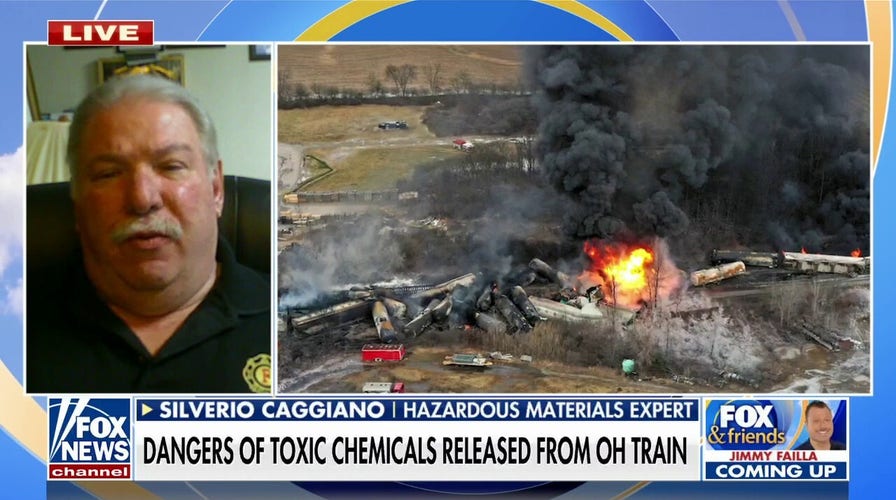Ohio Train Derailment: The Extended Presence Of Hazardous Chemicals In Structures

Table of Contents
Types of Hazardous Chemicals and Their Persistence
The Ohio train derailment involved a variety of hazardous chemicals, most notably vinyl chloride and butyl acrylate. Understanding the properties of these chemicals is crucial to grasping the extent of the ongoing contamination. Vinyl chloride, a known carcinogen, is a volatile organic compound (VOC) meaning it readily evaporates into the air. Butyl acrylate, another VOC, is also highly reactive and can form harmful byproducts. These properties contribute to their persistence in the environment and their potential for long-term impact.
- Chemical Leaching: These chemicals can leach into the soil and groundwater, contaminating drinking water sources and impacting local ecosystems.
- Absorption into Building Materials: Vinyl chloride and butyl acrylate can be absorbed into various building materials, including wood, concrete, and even paint, leading to persistent contamination within structures. This means that even after the initial cleanup, hazardous chemicals may remain trapped within these materials, slowly releasing over time.
- Long-Term Health Risks: Exposure to these chemicals, even at low levels, can lead to a range of acute and chronic health problems, including respiratory issues, liver damage, and an increased risk of cancer. Long-term exposure poses a particularly significant threat to the health of residents and first responders.
Challenges in Remediation and Cleanup
Removing hazardous chemicals from affected structures presents numerous complex challenges. The diverse building materials in the affected area, coupled with the potential for chemical interactions, complicate the remediation process.
- Specialized Equipment and Expertise: Effective cleanup requires specialized equipment and highly trained personnel experienced in handling hazardous materials. The sheer scale of the contamination necessitates a substantial investment in resources.
- Cost and Time: Comprehensive cleanup is both expensive and time-consuming. The process requires careful planning, thorough testing, and meticulous execution, potentially taking years to complete.
- Incomplete Remediation: There's a significant risk of incomplete remediation, leaving behind residual contamination that can continue to pose a threat to public health and the environment. Thorough monitoring and long-term assessments are crucial.
Long-Term Health and Environmental Impacts
The long-term consequences of the Ohio train derailment are potentially far-reaching, impacting both human health and the environment.
- Increased Health Risks: Residents and first responders face increased risks of various cancers, respiratory illnesses, and other health problems due to exposure to these hazardous chemicals. Long-term health monitoring programs are essential to track and address these potential health impacts.
- Environmental Damage: The contamination of soil, water, and air poses a significant threat to wildlife and local ecosystems. The long-term effects on biodiversity and ecosystem function require ongoing study and mitigation efforts.
- Ongoing Monitoring: Continuous monitoring of soil, water, and air quality is crucial to assess the extent of contamination and guide effective remediation strategies. Regular health assessments for residents and first responders are equally important.
Regulatory Response and Accountability
The regulatory response to the Ohio train derailment and its effectiveness in addressing long-term chemical contamination is a key area of concern.
- Regulatory Adequacy: The adequacy of existing regulations and enforcement mechanisms is under scrutiny. The incident highlights the need for improved safety standards and stricter regulations for the transportation of hazardous materials.
- Legal Accountability: The legal and ethical responsibilities of involved parties, including the railroad company and government agencies, are central to ensuring accountability and compensating affected individuals and communities. Legal action may be necessary to secure appropriate compensation and prevent future incidents.
- Prevention of Future Incidents: The Ohio train derailment underscores the critical need for stricter regulations, improved safety protocols, and enhanced oversight to prevent similar catastrophic events in the future. Investment in infrastructure upgrades and improved training are also essential.
Conclusion:
The extended presence of hazardous chemicals in structures following the Ohio train derailment presents a severe and ongoing threat to public health and the environment. The challenges involved in remediation are significant, and long-term monitoring and health assessments are crucial. We must demand accountability from responsible parties and advocate for stronger regulations to prevent future Ohio train derailment hazardous chemical incidents. Stay informed about the latest developments regarding the long-term effects of the Ohio train derailment hazardous chemicals and demand accountability from responsible parties. Learn more about the ongoing cleanup efforts and support initiatives aimed at mitigating the lingering presence of hazardous chemicals in affected structures. The health and well-being of communities depend on a robust and effective response to this crisis.

Featured Posts
-
 Sikker Kjoring I Sor Norske Fjell Forberedelser For Vintervaer
May 09, 2025
Sikker Kjoring I Sor Norske Fjell Forberedelser For Vintervaer
May 09, 2025 -
 Uk Visa Restrictions Impact On Pakistan Nigeria And Sri Lanka
May 09, 2025
Uk Visa Restrictions Impact On Pakistan Nigeria And Sri Lanka
May 09, 2025 -
 16 Million Penalty For T Mobile Details Of Three Year Data Breach Settlement
May 09, 2025
16 Million Penalty For T Mobile Details Of Three Year Data Breach Settlement
May 09, 2025 -
 Colognes Bundesliga 2 Victory Matchday 27 Overview
May 09, 2025
Colognes Bundesliga 2 Victory Matchday 27 Overview
May 09, 2025 -
 Increased Scrutiny For Nigerian Visa Applicants In The Uk
May 09, 2025
Increased Scrutiny For Nigerian Visa Applicants In The Uk
May 09, 2025
